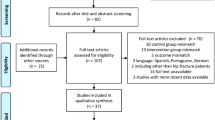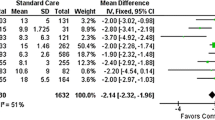Abstract
This article summarizes the detailed cost-effectiveness analysis of delirium prevention interventions in people undergoing surgical repair of hip fracture. We compared a multi-component delirium prevention intervention with usual care using a model based on a decision tree analysis. The model was used to estimate the incremental net monetary benefit (INMB). The robustness of the cost-effectiveness result was explored using deterministic and probabilistic sensitivity analyses. The multi-component prevention intervention was cost-effective when compared to usual care. It was associated with an INMB of £8,180 using a cost-effectiveness threshold of £20,000 per QALY. It remained cost-effective in the majority of the deterministic sensitivity analyses and was cost-effective in 96.4 % of the simulations carried out in the probabilistic sensitivity analysis. We have demonstrated the cost-effectiveness of a multi-component delirium prevention intervention that targets modifiable risk factors for delirium in older people undergoing surgical repair of hip fracture. It is an attractive intervention for practitioners and health care policy makers as they address the double burden of hip fracture and delirium.



Similar content being viewed by others
References
British Orthopaedic Association (2007) The care of patients with fragility fractures. http://www.bgs.org.uk/pdf_cms/pubs/Blue%20Book%20on%20fragility%20fracture%20care.pdf. Accessed Jun 2011
Holmes JD, House AO (2000) Psychiatric illness in hip fracture. Age Ageing 29:537–546
National Institute for Health and Clinical Excellence (2010) Delirium: diagnosis, prevention and management. London: National Institute for Health and Clinical Excellence; 2010. http://guidance.nice.org.uk/CG103/Guidance
O’Keeffe S, Lavan J (1997) The prognostic significance of delirium in older hospital patients. J Am Geriatr Soc 45(2):174–178
Holmes J, House A (2000) Psychiatric illness predicts poor outcome after surgery for hip fracture: a prospective cohort study. Psychol Med 30(4):921–929
Pitkala KH (2005) Prognostic Significance of Delirium in Frail Older People. Dement Geriatr Cogn Disord 19(2–3):158–163
Bourdel-Marchasson I, Vincent S, Germain C et al (2004) Delirium symptoms and low dietary intake in older inpatients are independent predictors of institutionalization: a 1-year prospective population-based study. J Gerontol Ser A Biol Sci Med Sci 59(4):350–354
Rockwood K, Cosway S, Carver D, Jarrett P, Stadnyk K, Fisk J (1999) The risk of dementia and death after delirium. Age Ageing 28(6):551–556
Thomason JW, Shintani A, Peterson JF, Pun BT, Jackson JC, Ely EW (2005) Intensive care unit delirium is an independent predictor of longer hospital stay: a prospective analysis of 261non-ventilated patients. Crit Care 9(4):R375–R381
Ely EW, Shintani A, Truman B et al (2004) Delirium as a predictor of mortality in mechanically ventilated patients in the intensive care unit. J Am Med Assoc 291(14):1753–1762
U.S.Department of Health and Human Services (2004) CMS statistics. 34 (CMS Pub. No. 03445). Centers for Medicare and Medicaid Services, Washington, DC
Marcantonio ER, Flacker JM, Wright RJ, Resnick NM (2001) Reducing delirium after hip fracture: a randomized trial. J Am Geriatr Soc 49(5):516–522
Harari D, Hopper A, Dhesi J, Babic-Illman G, Lockwood L, Martin F (2007) Proactive care of older people undergoing surgery (‘POPS’): designing. embedding, evaluating and funding a comprehensive geriatric assessment service for older elective surgical patients. Age Ageing 36(2):190–196
Gustafson Y, Brannstrom B, Berggren D, Ragnarsson JI, Sigaard J, Bucht G, Reiz S, Norberg A, Winblad B (1991) A Geriatric-anesthesiologic program to reduce acute confusional states in elderly patients treated for femoral neck fractures. J Am Geriatr Soc 39(7):655–662
National Institute for Health and Clinical Excellence (2008) Guide to the methods of technology appraisal. London. http://www.nice.org.uk/media/B52/A7/TAMethodsGuideUpdated
Wong DM, Niam T, Bruce JJ, Bruce DG (2005) Quality project to prevent delirium after hip fracture. Aust J Ageing 24(3):174–177
Clark M, Watts S (1994) The incidence of pressure sores within a national health service trust hospital during 1991. J Adv Nurs 20(1):33–36
Ekman M, Berg J, Wimo A, Jonsson L, McBurney C (2007) Health utilities in mild cognitive impairment and dementia: a population study in Sweden. Int J Geriatr Psychiatr 22(7):649–655
Hendriks MR, Evers SM, Bleijlevens MH, van Haastregt JC, Crebolder HF, van Eijk JT (2008) Cost-effectiveness of a multidisciplinary fall prevention program in community-dwelling elderly people: a randomized controlled trial. Int J Technol Assess Health Care 24(2):193–202
Personal Social Services Research Unit (2007) Dementia UK: the full report. The Alzheimer’s Society, London. http://www.alzheimers.org.uk/site/scripts/download.php?fileID=2
Netten A, Bebbington A, Darton R, Forder J, Miles K (1998) 1996 Survey of care homes for elderly people. Final report, PSSRU discussion paper 1423/2. Personal Social Services Research Unit, University of Canterbury, Kent
The NHS Information Centre, Hospital Episode Statistics for England, 2007–08
Bennett G, Dealey C, Posnett J (2004) The cost of pressure ulcers in the UK. Age Ageing 33(3):230–235
Iglesias CP, Manca A, Torgerson DJ (2009) The health-related quality of life and cost implications of falls in elderly women. Osteoporos Int 20(6):869–878
Netten A, Darton R, Bebbington A, Forder J, Brown P, Mummery K (2001) Residential and nursing home care of elderly people with cognitive impairment: prevalence, mortality and costs. Aging Mental Health 5:14–22
Ward S, Lloyd JM, Pandor A et al (2007) A systematic review and economic evaluation of statins for the prevention of coronary events. Health Technol Assess 11(14):1–160
Interim Life Tables, England and Wales, 2005–2007. http://www.ons.gov.uk/ons/publications/re-reference-tables.html?edition=tcm%3A77-61850. Accessed Jun 2008
McNamee P, Bond J, Buck D, Resource Implications Study of the Medical Research Council Cognitive Function and Ageing Study (2001) Costs of dementia in England and Wales in the 21st Century. Br J Psychiatr 179:261–266
Rizzo JA, Bogardus ST Jr, Leo-Summers L, Williams CS, Acampora D, Inouye SK (2001) Multicomponent targeted intervention to prevent delirium in hospitalized older patients: what is the economic value? Med Care 39(7):740–752
Acknowledgments
The method and results presented here draw completely from the full version of the NICE clinical guideline 103: the diagnosis, prevention and management of delirium (see reference 1). The guideline was developed by the National Clinical Guideline Centre which is funded by NICE. The important input of the Guideline Development Group is gratefully acknowledged. In the guideline, NICE recommends that a tailored multi-component delirium prevention intervention, delivered by a multidisciplinary team, should be provided in hospitals and in long-term care for people at risk of delirium. The economic evidence presented here was used to support this recommendation. The authors of this article are employed by the organizations for which they have provided contact details. They did not receive additional funding for writing this article. The views expressed in this article are those of the authors and not necessarily those of NICE or the organizations they work for. Anayo Akunne and Sarah Davis were working at the National Clinical Guideline Centre at the time the guideline was developed. We are particularly grateful to Lakshmi Murthy, whose work on the review that underpins the model was important. At the time the guideline was developed, Lakshmi Murthy was a Research Fellow at the National Clinical Guideline Centre.
Conflict of interest
Dr A Akunne, Ms S Davis and Dr M Westby were employed at the National Clinical Guideline Centre when the economic model that underpins this manuscript was developed. The Guideline Centre was funded by the UK National Institute for Health and Clinical Excellence to develop the guideline from which this manuscript was drawn. Prof J Young was involved in a Programme Grant for Delirium Prevention. The awarding institution was the National Institute for Health Research, UK.
Author information
Authors and Affiliations
Corresponding author
Rights and permissions
About this article
Cite this article
Akunne, A., Davis, S., Westby, M. et al. The cost-effectiveness of multi-component interventions to prevent delirium in older people undergoing surgical repair of hip fracture. Eur J Orthop Surg Traumatol 24, 187–195 (2014). https://doi.org/10.1007/s00590-013-1170-9
Received:
Accepted:
Published:
Issue Date:
DOI: https://doi.org/10.1007/s00590-013-1170-9




